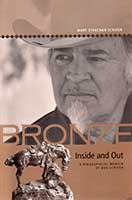by Roland Bohr
History Department University of Winnipeg
|
Mary S. Scriver, Bronze Inside and Out: A Biographical Memoir of Bob Scriver Calgary: University of Calgary Press, 2007, 400 pages, ISBN 9781552382271, $44.95 (paperback)
 Written by his wife, Bronze Inside and Out details the life of Western artist Bob Scriver, in a richly illustrated narrat ive ingeniously paralleling the stages of his life with the steps of creating a bronze sculpture, Scriver’s preferred artistic medium.
Written by his wife, Bronze Inside and Out details the life of Western artist Bob Scriver, in a richly illustrated narrat ive ingeniously paralleling the stages of his life with the steps of creating a bronze sculpture, Scriver’s preferred artistic medium.
Bob Scriver was born on the Blackfeet Reservation in Browning, Montana, in 1914, where his father and later his older brother ran a store trading to local Aboriginal people. After a career in music, Scriver turned towards visual arts in the tradition of early twentieth century Western painters like Frederick Remington and Charles M. Russell. However, in the 1960s Scriver eventually settled on bronze casting and became known for his dramatic renditions of western themes, such as wildlife, the Lewis and Clark expedition, ranching, and the Native peoples of the Plains, predominantly the Blackfeet.
Disaffected with formal Christianity after the death of his daughter, Scriver increasingly turned toward Blackfeet spirituality. Gradually he was initiated into the ranks of spiritual authorities among the Blackfeet, namely the owners of prestigious medicine bundles, culminating in his acquisition of a Thunder Medicine Pipe bundle from Richard Little Dog in 1969. Thus, unprecedented in Blackfeet spiritual culture, in an elaborate three-day ceremony one of the most prestigious and spiritually significant medicine bundles was formally transferred to a person of non-Aboriginal descent, making Scriver an acknowledged spiritual authority among the Blackfeet.
Besides his art, Scriver was known for an extensive collection of Blackfeet artefacts, begun by his father and brother. When federal legislation in regard to the return of spiritually significant Aboriginal artefacts to the communities of their origin was about to be enacted in the United States, Scriver decided to sell his collection, including his medicine bundles, to the Provincial Museum of Alberta (Royal Alberta Museum) in 1989. This sparked controversy on several levels, especially among Aboriginal communities in Montana and Alberta. While the Provincial government eventually “repatriated” parts of the collection to Blackfoot communities in Alberta, groups among the Montana Blackfeet protested, expressing their belief that Scriver had only held these artefacts in trust for them until the traditions pertaining to their use could be revitalized.
traditions pertaining to their use could be revitalized. When Bob Scriver passed away in 1999, most of these issues remained unresolved. In Bronze Inside and Out, Mary Scriver presents these events from a personal perspective, detailing her and her husband’s perception of Blackfeet history, spirituality and culture, Western art and life in and near an Aboriginal community in Montana.
Page revised: 14 June 2014